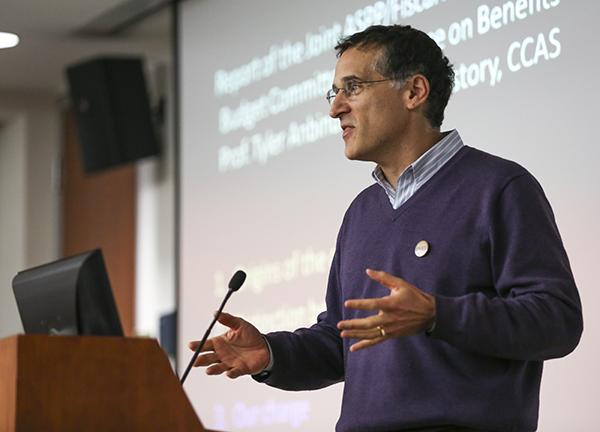
GW’s average total compensation for professors falls in the bottom half of its peer schools, though the average salary lands in the middle, a Faculty Senate committee reported Friday.
Faculty salaries at the University increased again last year, according to data that Provost Steven Lerman showed the Faculty Senate on Friday. Still, a committee reported that total compensation lags behind that of peer institutions and schools with similar costs of living because GW’s fringe benefits are small compared to those of its competitors.
The University typically raises faculty salaries by about 3 percent annually – an effort that helps compensation keep pace with inflation.
Last year, the average salary for a full-time professor was $161,400, up about 3.4 percent from the previous year. The average salary for associate professors was $109,400 and the average salary for assistant professors was $87,500.
By school, the GW Law School, Milken Institute School of Public Health and the GW School of Business pay the highest average salaries, while the Columbian College of Arts and Sciences and the Graduate School of Education and Human Development pay the least.
Lerman said last year’s pay was in line with other reports he has given in recent years.
When the committee adjusted salaries for the cost of living of the schools’ locations, it found that GW ranks in the bottom three among its peer schools for each professor rank.
Tyler Anbinder, a member of the Appointment, Salary and Promotion Policies committee who presented the data to the Faculty Senate, said the committee’s goal was to push GW to offer the same level of total compensation as do its competitor schools.
But that could be hard to do, as GW faces tighter budgets heading into the next fiscal year.
“GW ought to spend more on our benefits than is being spent now. At a minimum, we ought to be able to make it to the middle of the ranks,” Anbinder said.
The committee members said their analysis convinced them that the primary issue was how benefits compared proportionately to salary level, especially for lower-ranking professors.
Their report noted that GW might not have the financial ability to match its peer schools’ total compensation because only three of those 14 schools have an endowment-per-student ratio at or below GW’s. With a larger endowment, schools are able to spend more per student, which translates to making it easier to pay for smaller class sizes and give faculty better salaries.
“While endowment clearly affects how much a university can afford to pay its faculty, the data we have collected indicates that endowment is not the decisive factor that explains why GW’s benefits lag behind almost all comparable schools,” the report reads.
A task force that University President Steven Knapp called together in December has been looking at the methodology for how different institutions report compensation. Knapp said at the Faculty Senate meeting that the task force was looking at each of GW’s benefits plans separately and how they compare to other institutions’ ways of reporting.
“Are we reporting the things that others are reporting?” he said. “If we find out that we are and it’s all the way it looks, then obviously there has to be some work done on this.”







